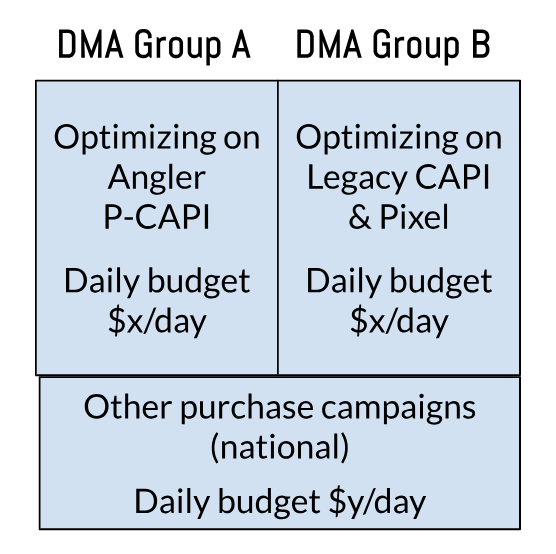Geo-Lift Incrementality Measurement of Angler Predictive CAPI
Step by step guide to setup 3rd party geo lift incrementality test to measure efficacy of Angler Predictive CAPI
Context
When brands seek to measure geo-lift incrementality using platforms such as Haus or Measured—specifically to compare the performance of campaigns optimized with Angler’s Predictive CAPI signals versus business-as-usual integrations (basic or advanced CAPI)—it’s essential to design the experiment to measure incrementality at the storefront or DMA level.
Theory vs. Practice
In theory, this would involve cloning all lower-funnel campaigns (those optimizing toward Purchase or New Customer Purchase events) and creating two variants per campaign:
- one targeting test DMAs, optimized with Angler’s Predictive CAPI events, and
- one targeting control DMAs, optimized with the standard browser + CAPI event setup.
However, this full-scale cloning approach is often impractical because:
- restarting all campaigns would reset learning phases across the ad account, and
- certain campaign types, such as ASC+, treat geo targeting as guidance rather than enforced restrictions.
A more practical methodology is to identify the key campaigns representing the majority of ad spend and create two geo-segmented variants:
- Variant A: runs in geo group A and optimizes using Angler P-CAPI events;
- Variant B: runs in geo group B and optimizes using standard browser / CAPI events.

Budget Allocations
We need to ensure that the test and control campaigns get majority of budget allocations, meanwhile, other bottom-funnel campaigns may continue running nationally across both DMA groups, provided their combined budget share does not exceed 20 % (ideally 10 %) of the daily ad-account spend on lower-funnel efforts. Upper- and mid-funnel campaigns can continue to operate nationally without any additional geo restrictions.
Updated 2 months ago
